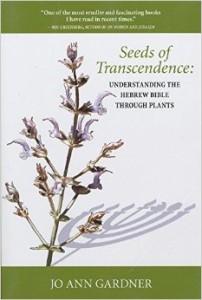Chana Thompson Shor
Our Agricultural Past, Our Spiritual Future
 With Seeds of Transcendence: Understanding the Hebrew Bible through Plants, Jo Ann Gardner has exceeded any standard compendium of plants of the Bible. Ambitiously crafted as a commentary, Gardner’s book (Decalogue Books, $29.95) explicates the cycle of yearly readings in the Hebrew Bible, including the history and significance of the plants along the way. She is familiar with commentaries of modern scholars, Talmudic opinions and midrash, along with modern research on biblical plants.
With Seeds of Transcendence: Understanding the Hebrew Bible through Plants, Jo Ann Gardner has exceeded any standard compendium of plants of the Bible. Ambitiously crafted as a commentary, Gardner’s book (Decalogue Books, $29.95) explicates the cycle of yearly readings in the Hebrew Bible, including the history and significance of the plants along the way. She is familiar with commentaries of modern scholars, Talmudic opinions and midrash, along with modern research on biblical plants.
Plant life was an important part of the background that ancient readers (or hearers) would have understood. At one point Abraham plants a tamarisk tree; an ancient would have recognized this as an act of piety. In the story of Rachel and Leah, we might have expected Rachel to become pregnant after using fertility-enhancing mandrakes. But it is Leah — who does not use the remedy — who becomes pregnant. The mandrakes’ “failure” in this case teaches the story’s theological point, which is that God is in control of Rachel’s fertility.
In addition to explicating the literary or theological significance of numerous plants, fruits and trees, Gardner also tackles the contextual importance of the change of seasons, the cycles of planting and harvest, and the contrasts between the different environments appearing in the Bible: Egypt, the Wilderness and the ancient Land of Israel.
Besides minor errors (watermelons were not yet pink in the days of the Pharaohs), Gardner’s overall approach is erudite and memorable. It is one thing to recall the flashy plants like the pomegranates and grapes which appear in most biblical descriptions of the Land of Israel. But in Gardner’s book we also learn about hyssop (a symbol of humility, as compared to the lofty cedar), the caper (known for its resilience), and the broom bush (Elijah’s shelter in the wilderness).
As a commentary in itself, Gardner’s work makes some interesting original points, but the book seems unable to make up its mind whether it is a modern commentary (incorporating the idea that the text of the Bible has a long history, derived from different sources), or to take a traditionalist approach (which assumes, e.g., that King David wrote all the psalms, or that the original audience for the agricultural laws was really the Israelites in the wilderness — who as yet had no context for understanding them). In some ways, the book acknowledges modern premises, but notably fails to incorporate some basic knowledge about Israelite history and religion — for example, our historical evolution from Abrahamic allegiance to a family god, through Israelite henotheism (worship of only one, but acknowledging the existence of others), on the way to Jewish monotheism.
However, despite its inconsistency as a biblical commentary, Seeds of Transcendence is a valuable botanical companion to the weekly readings. Until recently, Jews had a reputation (given that in recent history we were predominantly city-dwellers) of being out of touch with nature. This book — in tune with the agricultural awakening in modern Israel, and the increase of Jewish involvement in environmental movements and gardening — succeeds in conveying a fundamental message: Biblical references to plants, seasons and the land are not just a relic of our agricultural past, but are deeply entwined in the religious message of our sacred texts, and our spiritual future.
Chana Thompson Shor is a Conservative rabbi, the first woman mesader gittin (preparer of Jewish religious divorce), a Judaic fabric artist, and a writer.
 Please wait...
Please wait...